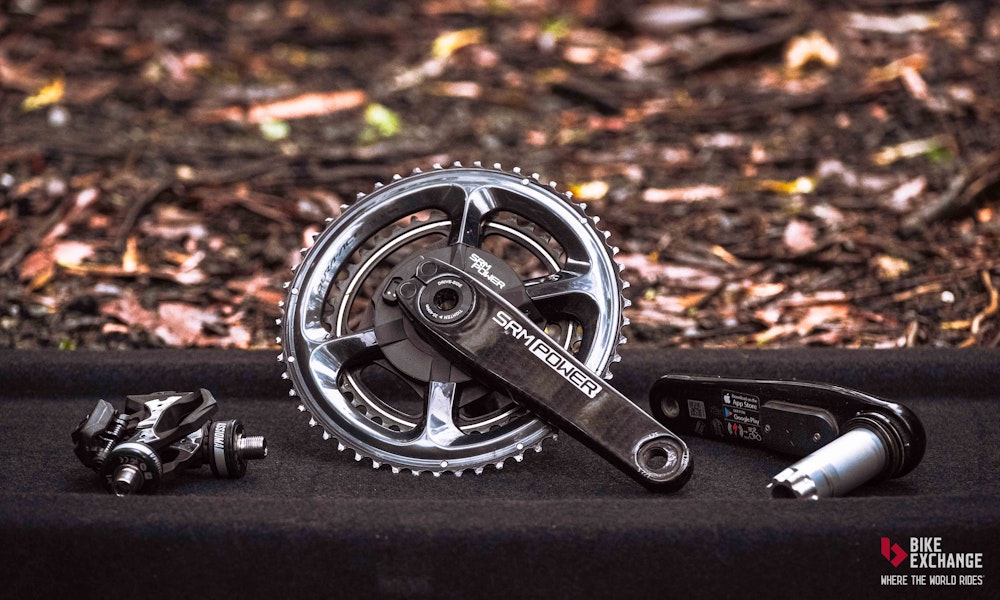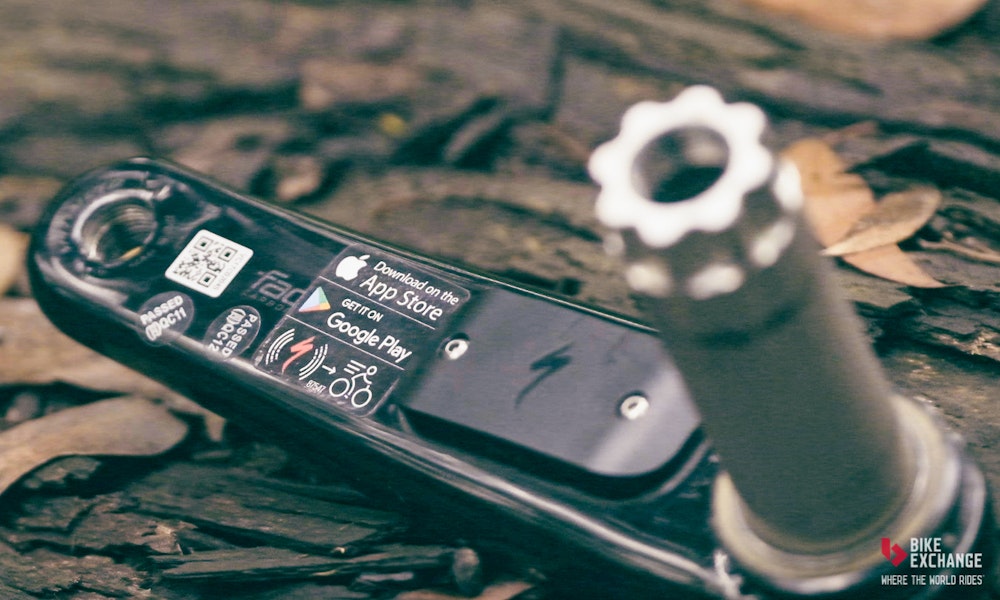Once reserved for WorldTour professionals and the truly dedicated, thanks to trickle-down economics, cycling power meters are more accessible, affordable and popular than ever. Responsible for tracking the power output from your legs, along with other metrics such as cadence, pedalling smoothness, power meters are regarded as one of the most effective training aids on offer for cycling enthusiasts.
So if you’re in the market for your first power meter and don’t know where to start or simply are weighing up your options on the different types of power meters on offer, this article will serve as the perfect guide to take you through all you need to know about Power Meters.
How Do They Work?

Before we take you through the different types of power meters on offer and what to expect for your budget, first, we’ll take you through how they work. Fundamentally, a power meter measures the wattage output from your legs with the aid of little electronic sensors known as a “Strain Gauge”. Strain gauges read these forces generated and relay the information to a compatible device such as a cycling computer, watch or even your smartphone.
In terms of connectivity, just about all power meters on the market will use ANT+ to connect them to a bike computer. The latest crop of power meters will also allow you to connect to devices using Bluetooth Smart.
In a nutshell, a power meter measures how hard you’re working and enables you to train much more precisely.
Why Use One?

The main reason for the use of power meters is for training purposes. After all, it’s one of the most effective tools cyclists can use to get stronger and more efficient on the bike. Before the widespread adoption of power meters, rider largely used methods such as “Rate of Perceived Effort” (RPE), i.e. self-scoring, how hard an effort was, or using heart rate data.
In essence, heart rate data proves to be problematic as, at times, especially in efficiency, raising the heart rate can be counter-productive. Additionally, power data is more or less instantaneous, whereas it can take some time for your heart rate to match your effort on the bike. As for RPE, the accuracy of the figures out of a power meter ensure you’re hitting your targets within 1-5% based on the unit you’ve invested in, which is much more accurate than perceiving your effort from day to day, which can fluctuate wildly based on several factors such as freshness and fatigue, fitness, weather conditions etc. In closing, using a power meter simply allows a rider to make the most of their training time, be it long or short.
The Different Types of Power Meters On Offer

Seeing as power meters are used across a wide range of cycling disciplines, there are several different variants on offer to suit just about every riding style and budget. The three most common places to measure power from are the pedals, the spider, aka chainrings), cranks and the wheel hub. We’ll touch on each of these, as well as the pros and cons of each different method below.
Pedals
Power meter pedals are one of the most versatile and popular power meter variants available on the market today. Their accuracy, straight forward installation, combined with the ability to swap them between bikes immediately quickly, makes them one of the most simple power meter solutions available.
Thanks to their simplicity, pedal power meters, along with single-sided crank arms, are largely responsible. The majority of pedal-based power meter systems utilise strain gauges placed in the pedal body itself and can take both single and dual-sided measurements, depending on the device. Most pedal power meters utilise the LOOK Keo cleat type, largely because the otherwise incredibly popular Shimano SPD-SL pedal and patents largely protect cleat designs.
Popular pedal-based power meter options include the Favero Assioma, Garmin Vector, SRM Exact, and the Powertap P2.
Spider
Crankset or spider-based power meters are some of the most common power meters on offer and work by utilising strain gauges located within the crank spider. In most cases, spider power meters require specific cranks or cranksets to function, however, can still be transferred between bikes, albeit with much more difficulty than pedal-based power meters. Spider based power meters can provide both single-sided and estimated left/right power.
Spider based cranksets are often the most popular option for professional athletes due to their accuracy and durability. Popular spider-based power meter options include the SRM Origin, FSA Powerbox, SRAM/Quarq AXS power meter spider, to name a few.
Crank Arm
As their name suggests, crank arm-based power meters measure the forces at the crank arm. As a result, crank arm power meters are available as both single and dual-sided options. Single-sided crank-arm power meters simply require riders to replace the left crank with a unit fitted with strain gauges, whereas for dual-sided power, the entire crankset will need to be replaced with a power equipped unit.
Thanks to their OEM compatibility with Shimano, SRAM and Campagnolo cranksets, single-sided crank arm power meters are amongst the most affordable options on the market. Popular crank arm-based power meters include options from Stages, 4iiii Innovations, Shimano, and Pioneer.
Bottom Bracket / Axle
Much like the crank and crank-arm power meters mentioned above, bottom bracket or axle power meters will often require a rider to replace their crankset with a power equipped unit. However, instead of the strain gauges being placed at the crank arms, the torque and power measurement is taken at the axle.
Popular bottom bracket/axle power meter options include the ROTOR InPower, and the Easton CINCH power meter.
Hub
Finally, the last commonplace for recording power is at the rear wheel, specifically the rear hub. As we move into 2021, PowerTap is the last mainstream supplier of hub-based power meters. As a power meter hub is required to be laced to a new wheelset, the cost of the wheelset combined with the price of the replacement hub is the main reason why hub power meters are going the way of the dodo, PowerTap included, which was recently removed from parent companies SRAM line-up altogether.
Single, Complete and Dual Sided Measuring

As eluded to above, there are some different ways to measure power, be it from a single source or sometimes a combination of sources to provide what’s known as complete power. We’ll go through these below;
Single-sided measurement will take power and cadence measurement from a single side of the bike. Single-sided measurements are common on the entry-level and affordable crank and pedal-based power meters.
Independent measuring power meters are capable of measuring the power from your left and right leg independently. This is typically found on power meters that measure power from each side, such as on pedal power meters or dual-sided crank power meters.
Complete power measures power from either a single or several different sources to provide the power metric. Complete power can be measured in many different ways, either centrally, i.e. at the axle, or as a combination of two or three different recording sources such as each crank or each pedal combined with the spider, bottom bracket or axle.
Other Metrics to Track

Power output or Watts is just one of a host of informative metrics that a power meter can measure. Other metrics such as cadence through to more complex metrics such as pedalling smoothness, torque efficiency and general cycling dynamics are tools that performance-orientated cyclists are using to train smarter.
These metrics essentially allow cyclists to use their power meters to map out deficiencies and strengths to optimise their pedal stroke to become more efficient and well-rounded riders.
Budget and What to Expect for your Money
While power meters are more affordable now than ever, it’s still worth noting that they’re still one of the most expensive components a rider can purchase outside of a frame, groupset or wheels. We’ll take you through what to expect for your budget below;
Entry-Level AU$300-$600

Starting at the entry-level, budget power meters are largely limited to non-direct force power meters or single-sided crank options. Non Direct force power meters refer to products placed on your bike and estimate power based on other factors such as wind resistance or other environmental factors. An example of this would be the PowerPod.
As for crank arm power meters, thanks to their OEM compatibility, manufacturers such as 4iiii, Pioneer, and Stages can offer single-sided power meter options mounted to a Shimano 105 level crank arm and is compatible with all Hollowtech II road Drivetrains. These retail for AU$549; however, can be found at sharper prices at some retailers.
Mid Range AU$600-$1200

Moving to the mid-range and this is where we see the majority of single and dual-sided pedal and higher-end single-sided crank-based power meters, as well as more affordable spider power meter options from the likes of FSA and Power2Max.
The pick in this price range for pedal power meters has to be the Favero Assioma Uno and Duo pedal power meter system. This is widely regarded as one of the best power meter options on the market thanks to its accuracy, price, battery life and durability.
Top-End AU$1200+

As you extend beyond AU$1200, this is where you start to look at dual-sided crankset options from the likes of Stages and Shimano, as well as higher-end spider-based power meters from SRAM and industry pioneers SRM. Power meters in this price point may not be any more accurate than top-end pedal-based power meters found in the mid-range; however, the key difference lies in durability, the technical features, and the materials used in the construction of the products.
Conclusion

In summary, if you’re looking to take your riding to the next level or simply unlock some additional fitness through training smarter, a power meter is one of the best performance products you can purchase. After all, training yourself to produce more watts per ride will yield more speed and efficiency than a set of bling carbon wheels at almost a third the cost!
What power meter is best for you ultimately depends on your budget and the features you’re looking for in a power meter. There is no perfect solution for all riders, but there may be an ideal solution for your individual needs based on where you’re looking to mount it, the budget you have and the features you’re looking for.
Thanks to Ride High Country for their support and hosting us during the creation of this article
Check out the range of Power meters on offer from our leading brands and retailers right here, at BikeExchange





